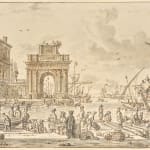
 Verso of the frame
Verso of the frame
 Detail of the signature
Detail of the signature
 Claude Lorrain - The Rising Sun - (1944-73-936) Philadelphia Museum of Art
Claude Lorrain - The Rising Sun - (1944-73-936) Philadelphia Museum of Art
 Jacobus Storck - Mediterranean Harbour Caprice - Christie's 08/10/2010
Jacobus Storck - Mediterranean Harbour Caprice - Christie's 08/10/2010
 Jacobus Storck - Imaginary Italian port - RP-T-1922-21 - Rijksmuseum Amsterdam
Jacobus Storck - Imaginary Italian port - RP-T-1922-21 - Rijksmuseum Amsterdam
Jacobus Storck
14.3 x 20 cm
Further images
-
(View a larger image of thumbnail 1
)

-
(View a larger image of thumbnail 2
)

-
(View a larger image of thumbnail 3
)

-
(View a larger image of thumbnail 4
)

-
(View a larger image of thumbnail 5
)

-
(View a larger image of thumbnail 6
)

-
(View a larger image of thumbnail 7
)

-
(View a larger image of thumbnail 8
)

Provenance
Eberhard Walter Kornfeld (1923 - 2023), stamped on reverse (L913b)
In this finely executed pen and wash drawing, Jacobus Storck presents us with an imaginary view in an Italian port. The splendor of the buildings (the large sculpted fountain surmounted by the statue of Neptune on the left, the palace and triumphal arch in the background) contrasts with the bustle of the sailors who are busy unloading an important ship.
This drawing is presented in a Louis XIII period frame with generous carving, the richness of which matches the meticulous detail of this harbor scene.
1. Jacobus Storck
Jacobus Storck was born into a family of marine artists: his father Johannes Sturckenburgh was also a marine painter, as were his two brothers Johannes (the eldest of the siblings) and Abraham (the youngest). His artistic career was relatively short, since all known dated works were executed between 1664 and 1687.
A lifelong resident of Amsterdam, in 1670 he made a trip (either alone or with his brother Abraham) along the Rhine to Speyer and Aschaffenburg (on the banks of the Main). He seems never to have visited Italy, although his port paintings often evoke an Italian atmosphere.
2. Description of the drawing and related artworks
Our drawing presents a view of an imaginary port, structured around three focal points that encourage the eye to move in a circular motion as it discovers the landscape. In the foreground, we discover a quay where some twenty sailors are busy discharging a vessel. On the far left of this quay stands a fountain with a wide basin topped by an ornate pedestal dominated by a statue of Neptune (recognizable by his trident). This decorative element provides a link with the background, in which the splendours of Baroque architecture are displayed: a vast palace with a loggia on its upper floor is surrounded by high walls topped by elaborate balustrades, leading to a large triumphal arch that opens out into the distance. Opposite this palace we see the stern of a ship being unloaded, while numerous ships appear in the background.
The presence of this triumphal arch seems purely decorative (no road seems to pass through it); it may have been inspired by the Arch of Trajan in the port of Ancona, or by the one depicted in Le Soleil Levant (The rising Sun), an engraving by Claude Lorrain dated 1634, from which the artist may also have freely drawn inspiration for the sailors and the piles of merchandise on the quay.
All these architectural elements (pedestals surmounted by statues, triumphal arch) are typical of the artist's painted or drawn work, as shown in the painting reproduced in the gallery.
Drawings by Storck of the quality shown here are quite rare on the market (and much rarer than his paintings). The only similar drawing we have found in a public collection belongs to the Rijksmuseum. Vertically oriented, it is quite different from the one we are presenting here, even if it includes many similarities (statue surmounting the column, sailors busy unloading, cloudy treatment of the sky...).
3. Framing
To frame this drawing, we chose a very exceptional Louis XIII period frame, distinguished by the vigorous, naturalistic treatment of the garlands of flowers carved on the uprights, composed of daisies (one at each center of the horizontal uprights), rosebuds (falling on the vertical uprights) and holly leaves (accompanied by berries). It seemed to us that this very opulent decoration went well with the Baroque spirit of the architectural background of this imaginary landscape.

